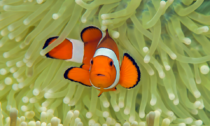
The charismatic clownfish – made famous by the popular film Finding Nemo – is a treasure trove for biological research, helping scientists answer a myriad of biological questions, such as how larvae disperse in the open oceans, or how coral reef fish will react to changes induced by global warming. While a comprehensive genome of the orange clownfish – the original Nemo – was published a few years ago, only recently did scientists manage to sequence the genome of the false clownfish (Amphiprion ocellaris) too, a related species found around Okinawa, the Philippines, Southeast Asia, and northwestern Australia.
“This genome, which is like the blueprint of the false clownfish, will be a very useful resource for scientists across biological fields,” said study co-lead author Dr. Marcela Herrera Sarrias, a postdoctoral researcher at the Okinawa Institute of Science and Technology Graduate University (OIST).
“We can use the false clownfish as a model species for studying ecology, evolution, adaption, development biology, and more,” explained study co-author Vincent Laudet, a professor of Life and Health Sciences at OIST.
The false clownfish lives in both tropical and subtropical regions, and relies upon sea anemones from coral reefs for survival. Like in the case of many other coral reef fish, their populations is expected to decline as coral reefs shrink due to climate change.
The researchers collected false clownfish from the waters near Onna-son, a village on the Okinawa Island, extracted samples of their DNA and RNA, and mapped in great detail their genomes. They found that – like its orange relative – the false clownfish belonged to a subfamily of anemonefish, which is made up of 28 fish species in total. In a further step, the scientists compared the genomes of the orange and false clownfish in order to find out what genes the two species shared but might be missing from the other 26 species.
“Evolutionary speaking, the two clownfish species are separated from the other 26 species in the subfamily,” said project leader Dr. Taewoo Ryu, an expert in the genetics of marine organisms at OIST. “We wanted to find out what makes them special.”
Dr. Ryu and his colleagues uncovered 70 genes that were conserved in the genomes of the orange and false clownfish, but not in the other 26 species. A considerable subset of these genes was related to neurobiological functioning, thus likely impacting the behavior and ecology of the two species of clownfish in ways that make them different from the other species of anemonefish.
“We’ve already started generating results using the published genome and there is a huge capacity for further climate change research on this species,” concluded study senior author Timothy Ravasi, a professor of Marine Sciences and Principal Investigator of the Marine Climate Change Unit at OIST. “This resource provides a new baseline to start other experiments.”
The study is published in the journal G3 Genes | Genomes | Genetics.












Social Profiles